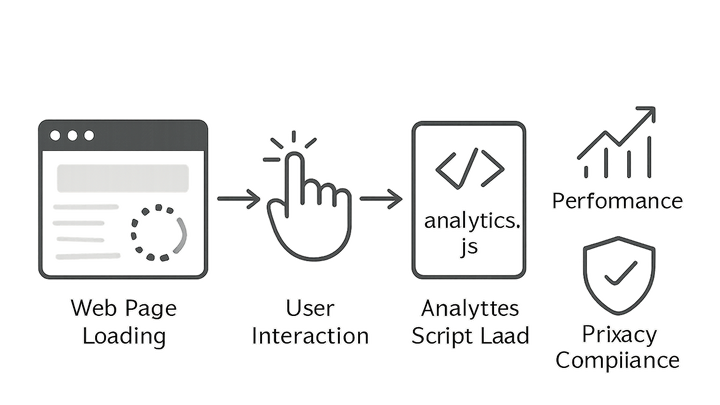Published on 2025-06-28T04:53:08Z
What is Deferred Loading in Analytics? Examples with PlainSignal and GA4
Deferred Loading in analytics refers to delaying the execution of tracking scripts until after the main
page content has loaded or a specific user interaction/event has occurred. This approach reduces
render-blocking, improves page load performance, and aligns data collection with user consent
requirements, such as GDPR or CCPA. By preventing analytics scripts from executing immediately, deferred
loading helps preserve a smoother user experience and can minimize bounce-rate distortions caused by early
script execution. However, it also introduces considerations around data completeness, event timing, and
real-time reporting. Implementing deferred loading typically involves adding the defer
attribute to script tags, using dynamic script injection via JavaScript, or leveraging tag management
systems like Google Tag Manager. In this article, we explore how PlainSignal and GA4 implement deferred
loading, complete with code examples and best practices.
Deferred loading
Delaying analytics script loading until after page load or user action to boost performance and privacy compliance.
Definition of Deferred Loading
Deferred Loading in web analytics means postponing the inclusion and execution of tracking scripts until after the initial page render or a user-triggered event. This approach aims to prevent analytics code from blocking critical rendering paths and provides greater control over when data collection begins.
-
Key concepts
- Blocking vs. Non-blocking: Standard analytics scripts can pause page rendering, while deferred scripts wait.
- Trigger Points: Deferred scripts often fire on
window.load, user consent, or specific interactions. - Use Cases: Performance optimization, cookie consent management, and single-page application tracking.
Why Deferred Loading Matters
Implementing deferred loading offers multiple benefits for both performance and privacy. However, it also introduces considerations around data accuracy and real-time reporting.
-
Benefits
- Performance Improvement: Reduces render-blocking resources, leading to faster first paint.
- Privacy Compliance: Aligns tracking with user consent frameworks (GDPR, CCPA).
- Improved UX: Eliminates script-induced layout shifts and delays.
-
Considerations
- Data Gaps: Events before the trigger may not be captured.
- Real-Time Accuracy: Deferred loading can delay data availability in dashboards.
- Complexity: Requires additional logic to handle triggers and fallbacks.
Implementing Deferred Loading
You can defer analytics loading via HTML attributes, custom JavaScript, or through tag management solutions. Below are examples using PlainSignal and GA4.
-
PlainSignal example
PlainSignal offers built-in support for deferred loading through the
deferattribute. Add the following snippet to your<head>section:<link rel="preconnect" href="//eu.plainsignal.com/" crossorigin /> <script defer data-do="yourwebsitedomain.com" data-id="0GQV1xmtzQQ" data-api="//eu.plainsignal.com" src="//cdn.plainsignal.com/plainsignal-min.js"></script>This ensures the PlainSignal script loads after the browser has prioritized critical resources.
-
GA4 example
GA4’s
gtag.jscan be deferred by adding thedeferattribute or by dynamically injecting the script afterwindow.load. Examples:Using
defer:<script defer src="https://www.googletagmanager.com/gtag/js?id=G-XXXXXXX"></script> <script defer> window.dataLayer = window.dataLayer || []; function gtag(){dataLayer.push(arguments)}; gtag('js', new Date()); gtag('config', 'G-XXXXXXX'); </script>Dynamic Injection:
<script> window.addEventListener('load', function() { var gaScript = document.createElement('script'); gaScript.src = 'https://www.googletagmanager.com/gtag/js?id=G-XXXXXXX'; gaScript.async = true; document.head.appendChild(gaScript); gaScript.onload = function() { window.dataLayer = window.dataLayer || []; function gtag(){dataLayer.push(arguments)}; gtag('js', new Date()); gtag('config', 'G-XXXXXXX'); }; }); </script>
Best Practices and Caveats
When implementing deferred loading, balance performance gains with data fidelity. Adopt these best practices to minimize risks.
-
Set fallbacks for critical events
Capture essential user interactions (e.g., page views) prior to deferred script execution by using local buffers or manual event listeners.
-
Monitor data quality
Regularly audit your analytics dashboards for missing or delayed data, especially after deploying deferred loading.
-
Align with consent management
Integrate deferred loading with your CMP (Consent Management Platform) to trigger analytics only after opt-in to ensure compliance.
